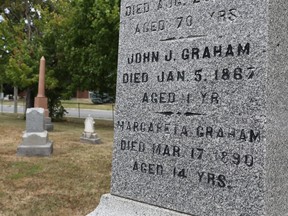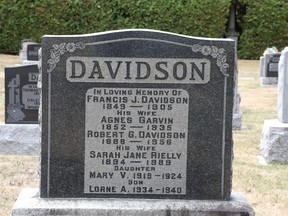Spears: Dead at age one — What childhood looked like before vaccines
The parents of the infants and young people buried in Bells Corners Union Cemetery would have given anything for a simple life-saving injection.

Article content
Little John Graham died near Ottawa in Canada’s Confederation year at the age of one. But the family had fresh hope when his sister Margareta arrived.
She died at 14.
Both are buried in a tiny cemetery that served a rural community, until Nepean grew around it. Today the Bells Corners Union Cemetery has heritage status — early Canadian history literally carved in stone.
The 19th-century stones also tell of Mildred Moore, who died one year old; Ellen Robertson, four; brothers William and John Davidson, five weeks and four years; Margaret Bell, 13; Mary Richardson, two; Willie Lafloor, 14; and more.
The early 1900s weren’t much kinder. Robert and Sarah Davidson lost their daughter Mary in 1924 and son Lorne in 1940. She was five, he was six. All these in a tiny community. Children, not statistics.
It was an era of more primitive medical care of course. No antibiotics or insulin, for example. But it was also a time of infectious diseases that ravaged our country in waves, and often it was the youngest who died.
My trips to the cemetery have me wondering why so many people want to return to those days, rejecting the widespread vaccinations that ended these epidemics.
A smallpox wave is believed to have killed 14,000 in British Columbia in 1862-63.
The year 1924 recorded more than 9,000 cases of diphtheria, according to Public Safety Canada, and the general rule was that one in 10 to 20 patients died. A diphtheria vaccine arrived in 1926, though we still have occasional cases, usually in visitors to Canada.
The worst year for polio was 1953, with 506 deaths and another 300 young people suffering lasting disabilities. A quick internet search will show you photos of children in rows of iron lungs, bravely smiling for the camera.
The parents of those children would have given anything for a simple life-saving injection. Today that is less true.
My trips to the cemetery have me wondering why so many people want to return to those days, rejecting the widespread vaccinations that ended these epidemics.
I tracked down Catherine Carstairs, who teaches about the history of health and medicine at the University of Guelph. “Child mortality was really high in the nineteenth century (from) communicable diseases — scarlet fever, measles even, and diphtheria,” she told me.
“Diphtheria is one of the ones that always gets me … We never think of diphtheria. It’s horrific.”
Many people today have no idea what the disease is, she noted. It clogs a person’s throat and mouth with lumpy little growths. Then it attacks the heart, kidneys and nervous system.
“Diphtheria has really been removed from our imagination but (it) was a real killer of children into the early years of the 20th century,” she said. “Those diseases could come back. We’re currently facing a measles epidemic largely among unvaccinated people.
“And it’s tragic for parents” to lose a child, she continued. “Sometimes there’s this dismissal, right?” People today can be unsympathetic, thinking that families long ago had a lot of children and that losing one wasn’t as tragic back then. “I just think that’s such condescension. It’s devastating for parents.”
I have little patience with those who want the benefits of modern medicine while claiming that this same medical practice is a plot against them, but my voice alone doesn’t matter. Then I found this cemetery, and its carved stone voices. They speak.

Yet we ignore their message too often. A few years back, I interviewed the pastor of a Texas church with a cluster of measles cases and she said her people should be vaccinated — unless they felt otherwise in their “heart of faith.” In which case skipping vaccination was just fine.
That is not skepticism. It is not the silly term “vaccine hesitancy.” It is a deliberate willingness to expose one’s family and neighbours to danger.
As a society we have lost the common memory of these pre-vaccine days. It is too easy to wish away disease, to say that we have better nutrition today, that the past is gone for good and we can disregard it.
But the little cemetery fenced in by cedars, with rows of stones all facing each hopeful sunrise, reminds us that the past still teaches us lessons if we listen.
Tom Spears is a longtime Ottawa news reporter with an interest in science.














Postmedia is committed to maintaining a lively but civil forum for discussion. Please keep comments relevant and respectful. Comments may take up to an hour to appear on the site. You will receive an email if there is a reply to your comment, an update to a thread you follow or if a user you follow comments. Visit our Community Guidelines for more information.